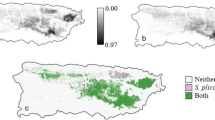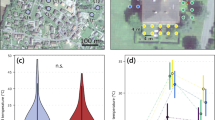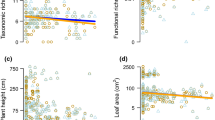Abstract
Urbanized landscapes are the theater of multiple simultaneous biological invasions likely to affect spread dynamics when co-occurring introduced species interact with each other. Interactions between widespread invaders call for particular attention because they are likely to be common and because non-additive outcomes of such associations might induce negative consequences (e.g., enhanced population growth increasing impacts or resistance to control). We explored the invasions of two widespread invasive taxa: the Japanese knotweed species complex Fallopia spp. and the invasive garden ant Lasius neglectus, in the urban area of Lyon (France). First, we investigated landscape habitat preferences as well as co-occurrence rates of the two species. We showed that Fallopia spp. and L. neglectus had broadly overlapping environmental preferences (measured by seven landscape variables), but their landscape co-occurrence pattern was random, indicating independent spread and non-obligatory association. Second, as Fallopia spp. produce extra-floral nectar, we estimated the amount of nectar L. neglectus used under field conditions without ant competitors. We estimated that L. neglectus collected 150–321 kg of nectar in the month of April (when nectar production is peaking) in a 1162 m2 knotweed patch, an amount likely to boost ant population growth. Finally, at six patches of Fallopia spp. surveyed, herbivory levels were low (1–6% loss of leaf surface area) but no relationship between ant abundance (native and invasive) and loss of leaf surface was found. Co-occurrences of Fallopia spp. and L. neglectus are likely to become more common as both taxa colonize landscapes, which could favor the spread and invasion success of the invasive ant.



Similar content being viewed by others
References
Aranda-Rickert A, Fracchia S, Yela N, Marazzi B (2017) Insights into a novel three-partner interaction between ants, coreids (Hemiptera: Coreidae) and extrafloral nectaries: implications for the study of protective mutualisms. Arthropod Plant Interact. https://doi.org/10.1007/s11829-016-9487-z
Arndt E, Grunert H, Schuler J (2011) Influence of inundation pattern on the epigaean ant fauna in a European floodplain forest complex (Hymenoptera: Formicidae). Entomol Gener 33:39–48
Bailey JP, Conolly AP (2000) Prize-winners to pariahs—a history of Japanese Knotweed s.l. (Polygonaceae) in the British Isles. Watsonia 23:93–110
Bailey JP, Wisskirchen R (2004) The distribution and origins of Fallopia × bohemica (Polygonaceae) in Europe. Nord J Bot 24:173–199
Bailey JP, Bímová K, Mandák B (2009) Asexual spread versus sexual reproduction and evolution in Japanese Knotweed s.l. sets the stage for the “Battle of the Clones”. Biol Invasions 11:1189–1203
Bates D, Maechler M, Bolker B, Walker S (2015) Fitting linear mixed-effects models using lme4. J Stat Softw 67:1–48
Bertelsmeier C, Courchamp F (2014) Future ant invasions in France. Environ Conserv 41:217–228
Cohen J (1960) A coefficient of agreement for nominal scales. Educ Psychol Meas 20:37–46
Cointat M (1953) Surface terrière des taillis de chêne vert. Revue forestière française 12:829–831
Cremer S, Ugelvig LV, Drijfhout FP et al (2008) The evolution of invasiveness in garden ants. PLoS ONE 3:e3338
Decrane LPR, Akeroyd JR (1988) Generic limits in Polygonum and related genera (Polygonaceae) on the basis of floral characters. Bot J Linn Soc 98:321–371
Djeddour DH, Shaw RH, Evans HC, Tanner RH, Seier M (2008) Could Fallopia japonica be the first target for classical weed biocontrol in Europe? In: Julien MH, Sforza R, Bon MC, Evans HC, Hatcher PE, Hinz HL, Rector BG (eds) Proceedings of the XIIth International Symposium on Biological Control of Weeds. CAB International, Wallingford, pp. 463–469
Dray S, Dufour A (2007) The ade4 package: implementing the duality diagram for ecologists. J Stat Softw 22:1–20
Dray S, Siberchicot A, Thioulouse J, Julien-Laferrière A (2016). adegraphics: An S4 lattice-based package for the representation of multivariate data. R package version 1.0-5
Espadaler X, Tartally A, Schultz R, Seifert B, Nagy C (2007) Regional trends and preliminary results on the local expansion rate in the invasive garden ant, Lasius neglectus (Hymenoptera, Formicidae). Insectes Soc 54: 293–301
Fisher MK, Shingleton AW (2001) Host plant and ants influence the honeydew sugar composition of aphids. Funct Ecol 15:544–550
Gippet JMW, Mondy N, Diallo-Dudek J, Bellec A, Dumet A, Mistler L, Kaufmann B (2017) I’m not like everybody else: urbanization factors shaping spatial distribution of native and invasive ants are species-specific. Urb Ecosyst 20:157–169
Griffith DM, Veech JA, Marsh CJ (2016) Co-occur: probabilistic species co-occurrence analysis in R. J Stat Softw 69:1–17
Henriksson A, Wardle DA, Trygg J, Dielh S, Englund G (2016) Strong invaders are strong defenders—implications for the resistance of invaded communities. Ecol Lett 19:487–494
Hijmans RJ, Cameron SE, Parra JL, Jones PG, Jarvis A (2005) Very high resolution interpolated climate surfaces for global land areas. Int J Climatol 25:1965–1978
Infoclimat.fr (2016) http://www.infoclimat.fr/stations-meteo/climato-moyennes-records.php?staid=07480&from=1981&to=2010&redirect=1. Last Accessed 25 Jan 2016
Jackson M (2015) Interactions among multiple invasive animals. Ecology 96:2035–2041
Kawano S, Azuma H, Ito M, Suzuki K (1999) Extrafloral nectaries and chemical signals of Fallopia japonica and Fallopia sachalinensis (Polygonaceae), and their roles as defense systems against insect herbivory. Plant Spec Biol 14:167–178
Koptur S (1992) Extrafloral nectary-mediated interactions between insects and plants. In: Bernays E (ed) Insect-plant interactions. CRC Press, Boca Raton, 81–130
Kuebbing SE, Nuñez MA (2015) Negative, neutral, and positive interactions among nonnative plants: patterns, processes, and management implications. Glob Change Biol 21:926–934
Kuebbing SE, Nuñez MA, Simberloff D (2013) Current mismatch between research and conservation efforts: the need to study co-occurring invasive plant species. Biol Conserv 160:121–129
Kuhn M. Contributions from Wing J, Weston S, Williams A, Keefer C, Engelhardt A, Cooper T, Mayer Z, Kenkel B, the R Core Team, Benesty M, Lescarbeau R, Ziem A, Scrucca L, Tang Y, Candan C (2016). caret: classification and regression training. R package version 6.0–70
Lach L (2007) A mutualism with a native membracid facilitates pollinator displacement by argentine ants. Ecology 88:1994–2004
Lach L, Hobbs RJ, Majer JD (2009) Herbivory-induced extrafloral nectar increases native and invasive ant worker survival. Popul Ecol 51:237–243
MacNeil C, Dick JT (2014) The enemy of my enemy is my friend: intraguild predation between invaders and natives facilitates coexistence with shared invasive prey. Biol Lett 10:20140398
Marazzi B, Bronstein JL, Koptur S (2013) The diversity, ecology and evolution of extrafloral nectaries: current perspectives and future challenges. Ann Bot-London 111:1243–1250
Nagy C, Tartally A, Vilisics F et al (2009) Effects of the invasive garden ant. Lasius neglectus Van Loon, Boomsma and András-Falvy, 1990 (Hymenoptera: Formicidae), on arthropod assemblages: pattern analyses in the type supercolony. Myrmecolog News 12:171–181
Ness JH, Morales MA, Kenison E, Leduc E, Leipzig-Scott P, Rollinson E, Swimm BJ, von Allmen DR (2013) Reciprocally beneficial interactions between introduced plants and ants are induced by the presence of a third introduced species. Oikos 122:695–704
Paris CI (2007) Above-belowground effects of the invasive ant Lasius neglectus in an urban holm oak forest, PhD thesis. Universitat Autonoma de Barcelona, Barcelona
Paris CI, Espadaler X (2009) Honeydew collection by the invasive garden ant Lasius neglectus versus the native ant L. grandis. Arthropod-Plant Int 3:75–85
Pate JS, Peoples MB, Storer PJ, Atkins CA (1985) The extrafloral nectaries of cowpea (Vigna unguiculata (L.) Walp. II. Nectar composition, origin of nectar solutes, and nectary functioning. Planta 166:28–38
R Core Team (2015). R: a language and environment for statistical computing. R Foundation for Statistical Computing, Vienna. https://www.R-project.org/
Rasband WS, ImageJ U.S. National Institutes of Health, Bethesda, Maryland, USA, http://imagej.nih.gov/ij/ (1997–2015)
Rouifed S, Piola F, Spiegelberger T (2014) Invasion by Fallopia spp. in a French upland region is related to anthropogenic disturbances. Basic Appl Ecol 15:435–443
Roura-Pascual N, Bas JM, Thuiller W, Hui C, Krug RM, Brotons L (2009) From introduction to equilibrium: reconstructing the invasive pathways of the Argentine ant in a Mediterranean region. Global Change Biol 15:2101–2115
Rowles AD, Silverman J (2009) Carbohydrate supply limits invasion of natural communities by Argentine ants. Oecologia 161:161–171
Roy R, Schmitt AJ, Thomas JB, Carter CJ (2017) Nectar biology: from molecules to ecosystems. Plant Sci 262:148–164
Schultz R, Seifert B (2005) Lasius neglectus (Hymenoptera: Formicidae) a widely distributed tramp species in Central Asia. Myrmecol Nachr 7:47–50
Seifert B (2007) Die Ameisen Mittel- und Nordeuropas. Lutra Verlags- und Vertriebsgesellschaft, Tauer, p. 368
Simberloff D, Von Holle B (1999) Positive interactions of nonindigenous species. Invasional Meltdown? Biol Invasions 1:21–32
Tartally A, Antonova V, Espadaler X, Csősz S, Czechowski W (2016) Collapse of the invasive garden ant, Lasius neglectus, populations in four European countries. Biol Invasions 18:3127–3131
Ugelvig LV, Drijfhout FP, Kronauer DJC, Boomsma JJ, Pedersen JS, Cremer S (2008) The introduction history of invasive garden ants in Europe: integrating genetic, chemical and behavioural approaches. BMC Biol 14:1–14
Van Loon AJ, Boomsma JJ, Andrasfalvy A (1990) A new polygynous Lasius species (Hymenoptera: Formicidae) from central Europe. I. Description and general biology. Insect Soc 37:348–362
Veech (2013) A probabilistic model for analysing species co-occurrence. Glob Ecol Biogeogr 22: 252–260
Venables WN, Ripley BD (2002) Modern applied statistics with S. 4th edn. Springer, New York. ISBN 0-387-95457-0
Vitousek PM, Mooney HA, Lubchenco J, Melilo JM (1997) Human domination of Earth's ecosystems. Science 277:494–499
Völkl W, Woodring J, Fischer M, Lorenz MW, Hoffmann KH (1999) Ant-aphid mutualisms: the impact of honeydew production and honeydew sugar composition on ant preferences. Oecologia 118:483–491
Wunderground.com (2017) https://www.wunderground.com/history/airport/LFLY/2011/4/1/CustomHistory.html?dayend=31&monthend=4&yearend=2011&req_city=&req_state=&req_statename=&reqdb.zip=&reqdb.magic=&reqdb.wmo=&MR=1. Last Accessed 7 Oct 2017
Acknowledgements
The study was funded by the Conseil Départemental de l’Isère. This work was supported by the LABEX IMU (ANR-10-LABX-0088) of Université de Lyon, within the program “Investissements d’Avenir” (ANR-11-IDEX-0007) operated by the French National Research Agency (ANR). The authors wish to thank the many students and interns who participated in the extensive sampling and identification of ants over the years. Additional thanks go to M. Amiez, D. Archundia, C. Brunet, M. Demarcy, A. Dumet, A. Grimaud, A. Kong Win Chang E. Nicolay, and L. Mistler who provided essential help in field sampling, experimentation, and data processing. The authors also thank the anonymous reviewers who greatly helped to improve the manuscript.
Author information
Authors and Affiliations
Corresponding author
Additional information
Handling Editor: Livy Williams.
Electronic supplementary material
Below is the link to the electronic supplementary material.
Rights and permissions
About this article
Cite this article
Gippet, J.M.W., Piola, F., Rouifed, S. et al. Multiple invasions in urbanized landscapes: interactions between the invasive garden ant Lasius neglectus and Japanese knotweeds (Fallopia spp.). Arthropod-Plant Interactions 12, 351–360 (2018). https://doi.org/10.1007/s11829-017-9589-2
Received:
Accepted:
Published:
Issue Date:
DOI: https://doi.org/10.1007/s11829-017-9589-2




